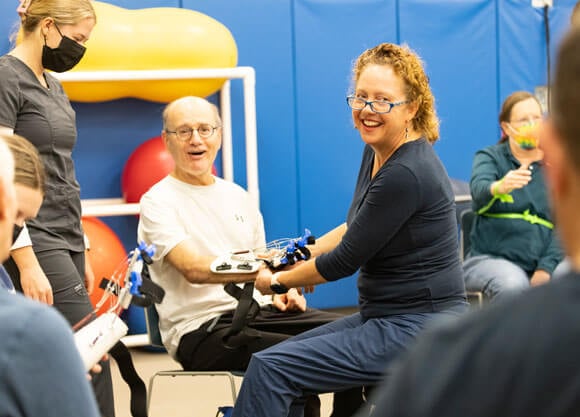
Alumna launches nonprofit for stroke survivors
January 09, 2023

January 09, 2023

Though they were technically meeting face to face for the first time, the survivors are a part of an online community brought together by Quinnipiac alumna and part-time clinical instructor Carolyn Brown, OTD ’20, who believes that when it comes to stroke recovery, human connection has healing power.
Brown is harnessing that restorative energy to tackle disparity in healthcare through her nonprofit organization, StrokeOT. Designed during her capstone project as a Quinnipiac OT doctoral candidate, Brown created StrokeOT to help bridge the gap in occupational therapy services for the underinsured while improving insurance standards for all stroke survivors. Through her work, Brown is the embodiment of the Quinnipiac OT program mission to create meaningful change in the health and functioning of individuals, populations and communities.
StrokeOT began in 2019 as an eight-week program of stretching exercises for five stroke survivors. Since then, it has grown into a community of more than 130 individuals participating in multiple exercise sessions, social group gatherings, guest speaker programs, adapted yoga and a book club. Each week, the StrokeOT website explores specific topics related to chronic stroke symptoms to help educate, empower and encourage stroke survivors to manage and take charge of their recovery.
As an occupational therapist, Brown has worked closely with the neurological population, specifically those recovering from stroke and brain injury. Building off her clinical expertise, she adapted the StrokeOT program from the University of Southern California Lifestyle Redesign Model that promotes managing chronic conditions through healthier lifestyles. In the beginning, Brown held OT sessions in a local hospital before transitioning to an online model during the COVID lockdown. The shift revealed a surprising benefit for her StrokeOT participants.
“After the lockdown, I figured people would want to go back to in-person sessions,” said Brown. “But to my surprise, my group wanted to continue online. I realized one of the major issues for stroke survivors is a lack of transportation and social isolation. The online format that started during COVID offered an in-home way to exercise in a group setting without having to rely on a caregiver for a ride.”
Relationships formed online soon developed into a robust support group that included in-person outings for coffee, craft beer tastings and socializing. StrokeOT officially became a nonprofit organization in 2021, with a dedicated board of nine professionals including stroke survivors, occupational therapists and legal experts offering insight and guidance.
In addition, Brown is also actively involved in several research studies focused on the benefits of group dynamics in the telehealth or in-person setting. She recently completed a year-long study that showed significant gains in balance and function when cardiovascular exercise and occupational performance coaching were combined in the telehealth platform.
“Occupational injustice occurs when a person is excluded or deprived from an opportunity to pursue something that is meaningful to them. These stroke survivors can’t participate in occupational therapy services because they’re underinsured or lack caregiver support. No one is addressing that occupational injustice,” said Brown. “Health insurance companies believe that a group of survivors exercising together is not necessarily a skilled OT service. I’m hoping our work will begin to shift some of those perceptions.”
According to Brown, stroke is the most common cause of long-term disability in the U.S. But most insurance plans will only cover OT services during the months immediately following a stroke.
“We’ve learned through the discovery of brain plasticity, that patients can make progress throughout their entire life after a stroke,” said Brown. “Unfortunately, stroke patients are often lumped in with other orthopedic diagnoses that show drastic improvements early in recovery. But stroke is not the same as an orthopedic injury. Recovery occurs in stages and may not happen immediately during the first 3-7 months after a stroke. We need to look at this as a marathon and not a sprint.”
When it comes to patient care, Brown draws from 28 years of clinical practice as an OT. But it’s her drive that comes from a deep reserve of personal experience as an underinsured child with limited access to life-altering rehabilitation services.
“I was a congenital amputee. I think my desire to help the underserved was laid down as a foundation early in my childhood,” said Brown. “As I began to design my capstone project at Quinnipiac, I felt strongly that I wanted to channel my personal experiences and create a program that would serve the underserved.”
In addition to her work with StrokeOT, Brown is an occupational therapist at Connecticut’s Hospital for Special Care and remains connected to her alma mater as a fieldwork supervisor, working with Quinnipiac OT students. She notes that if she ever starts to feel overwhelmed, she can always find inspiration in the community of survivors she has helped to create.
“Two people in my group were discharged from therapy and told they may never walk again,” said Brown. “After six months of participating in our cardiovascular aerobics group, they are both able to stand and their endurance has improved. It’s those wonderful moments that make all the hard work worth it.”
Quinnipiac Today is your source for what's happening throughout #BobcatNation. Sign up for our weekly email newsletter to be among the first to know about news, events and members of our Bobcat family who are making a positive difference in our world.
Sign Up Now